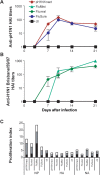Assessment of the efficacy of commercially available and candidate vaccines against a pandemic H1N1 2009 virus
- PMID: 20170374
- PMCID: PMC7109664
- DOI: 10.1086/651171
Assessment of the efficacy of commercially available and candidate vaccines against a pandemic H1N1 2009 virus
Abstract
Background: The emergence and global spread of the pandemic H1N1 2009 influenza virus have raised questions regarding the protective effect of available seasonal vaccines and the efficacy of a newly produced matched vaccine.
Methods: Ferrets were immunized with the 2008-2009 formulations of commercially available live attenuated (FluMist; MedImmune) or split-inactivated (Fluviral; GlaxoSmithKline) vaccines, a commercial swine vaccine (FluSure; Pfizer), or a laboratory-produced matched inactivated whole-virus vaccine (A/Mexico/InDRE4487/2009). Adaptive immune responses were monitored, and the animals were challenged with A/Mexico/InDRE4487/2009 after 5 weeks.
Results: Only animals that received the swine or matched vaccines developed detectable hemagglutination-inhibiting antibodies against the challenge virus, whereas a T cell response was exclusively detected in animals vaccinated with FluMist. After challenge, all animals had high levels of virus replication in the upper respiratory tract. However, preexisting anti-pandemic H1N1 2009 antibodies resulted in reduced clinical signs and improved survival. Surprisingly, FluMist was associated with a slight increase in mortality and greater lung damage, which correlated with early up-regulation of interleukin-10.
Conclusions: The present study demonstrates that a single dose of matched inactivated vaccine confers partial protection against a pandemic H1N1 2009 virus, and it suggests that a higher dose or prime-boost regimen may be required. The consequences of mismatched immunity to influenza merit further investigation.
Figures





Similar articles
-
Efficacy of A/H1N1/2009 split inactivated influenza A vaccine (GC1115) in mice and ferrets.J Microbiol. 2019 Feb;57(2):163-169. doi: 10.1007/s12275-019-8504-1. Epub 2019 Jan 31. J Microbiol. 2019. PMID: 30706345
-
Efficacy of seasonal live attenuated influenza vaccine against virus replication and transmission of a pandemic 2009 H1N1 virus in ferrets.Vaccine. 2011 Apr 5;29(16):2887-94. doi: 10.1016/j.vaccine.2011.02.014. Epub 2011 Feb 21. Vaccine. 2011. PMID: 21338676
-
Comparison of a live attenuated 2009 H1N1 vaccine with seasonal influenza vaccines against 2009 pandemic H1N1 virus infection in mice and ferrets.J Infect Dis. 2011 Apr 1;203(7):930-6. doi: 10.1093/infdis/jiq144. Epub 2011 Jan 21. J Infect Dis. 2011. PMID: 21257740 Free PMC article.
-
M2SR, a novel live influenza vaccine, protects mice and ferrets against highly pathogenic avian influenza.Vaccine. 2017 Jul 24;35(33):4177-4183. doi: 10.1016/j.vaccine.2017.06.039. Epub 2017 Jun 28. Vaccine. 2017. PMID: 28668565 Free PMC article.
-
Influenza virus vaccine live intranasal--MedImmune vaccines: CAIV-T, influenza vaccine live intranasal.Drugs R D. 2003;4(5):312-9. doi: 10.2165/00126839-200304050-00007. Drugs R D. 2003. PMID: 12952502 Review.
Cited by
-
TaqMan real time RT-PCR assays for detecting ferret innate and adaptive immune responses.J Virol Methods. 2014 Sep 1;205:38-52. doi: 10.1016/j.jviromet.2014.04.014. Epub 2014 May 4. J Virol Methods. 2014. PMID: 24797460 Free PMC article.
-
The role of IgG Fc receptors in antibody-dependent enhancement.Nat Rev Immunol. 2020 Oct;20(10):633-643. doi: 10.1038/s41577-020-00410-0. Epub 2020 Aug 11. Nat Rev Immunol. 2020. PMID: 32782358 Free PMC article. Review.
-
Seasonal influenza infection and live vaccine prime for a response to the 2009 pandemic H1N1 vaccine.Proc Natl Acad Sci U S A. 2011 Jan 18;108(3):1140-5. doi: 10.1073/pnas.1009908108. Epub 2011 Jan 3. Proc Natl Acad Sci U S A. 2011. PMID: 21199945 Free PMC article.
-
B Cell Activation and Response Regulation During Viral Infections.Viral Immunol. 2020 May;33(4):294-306. doi: 10.1089/vim.2019.0207. Epub 2020 Apr 23. Viral Immunol. 2020. PMID: 32326852 Free PMC article. Review.
-
DNA vaccination elicits protective immune responses against pandemic and classic swine influenza viruses in pigs.Clin Vaccine Immunol. 2011 Nov;18(11):1987-95. doi: 10.1128/CVI.05171-11. Epub 2011 Sep 14. Clin Vaccine Immunol. 2011. PMID: 21918118 Free PMC article.
References
-
- World Health Organization (WHO) Pandemic (H1N1) 2009-update 60. Geneva, Switzerland: WHO, 31 July 2009.
-
- Perez-Padilla R, de la Rosa-Zamboni D, Ponce de Leon S, et al. Pneumonia and respiratory failure from swine-origin influenza A (H1N1) in Mexico. N Engl J Med. 2009;361:680–689. - PubMed
-
- Chowell G, Bertozzi SM, Colchero MA, et al. Severe respiratory disease concurrent with the circulation of H1N1 influenza. N Engl J Med. 2009;361:674–679. - PubMed
Publication types
MeSH terms
Substances
Grants and funding
LinkOut - more resources
Full Text Sources
Medical

